Research on Grassland Fire Prevention Capabilities and Influencing Factors in Qinghai Province, China
Abstract
1. Introduction
2. Materials and Methods
2.1. Overview of the Study Area
2.2. Data Source
2.3. Research Methods
2.3.1. Evaluation Index System for Grassland Fire Prevention Capabilities
2.3.2. Grassland Fire Prevention Capability Model
2.3.3. Quantile Regression Model
3. Results
3.1. Residents’ Ability to Prevent Grassland Fires
3.1.1. Results of Grassland Fire Prevention Capabilities
3.1.2. Comparative Analysis of Grassland Fire Prevention Capacities Across Agricultural and Livestock Production Systems
3.2. Factors Affecting Residents’ Ability to Prevent Grassland Fires
4. Discussion
4.1. Differences in Residents’ Grassland Fire Prevention Capabilities
4.2. Factors Affecting the Ability to Prevent Grassland Fires
5. Conclusions
Author Contributions
Funding
Institutional Review Board Statement
Informed Consent Statement
Data Availability Statement
Acknowledgments
Conflicts of Interest
References
- Yu, B.; Lv, C. Assessment of ecological vulnerability on the Tibetan Plateau. Geogr. Res. 2011, 30, 2289–2295. [Google Scholar]
- Mofokeng, O.D.; Adelabu, S.A.; Jackson, C.M. An Integrated Grassland Fire-Danger-Assessment System for a Mountainous National Park Using Geospatial Modelling Techniques. Fire 2024, 7, 61. [Google Scholar] [CrossRef]
- Ding, J.; Zhong, H.; Xu, L.; Yu, J. Comparison of Township Disaster Reduction Capacity Assessment Results Based on Three Methods: A Case Study for 18 Townships in a Certain Distnict of a City. J. Catastrophol. 2024, 39, 80–88. [Google Scholar]
- Zheng, Y. Considerations on social defense against meteorological disasters and the government’s enhancement of disaster management capabilities. Public Commun. Sci. Technol. 2019, 11, 166–167. [Google Scholar]
- Hu, Y.; Zeng, G. Disaster Mitigation and Prevention by Paying Attention to Global Climate Change. Environ. Sci. Surv. 2011, 30, 15–18. [Google Scholar]
- Qin, L.; Zhang, Q.; Guo, J. The Practice and Experience of Meteorological Disaster Prevention and Mitigation in Other Countries. China Popul. Resour. Environ. 2014, 24, 349–354. [Google Scholar]
- Shen, L. Canadian Disaster Prevention and Mitigation Addressing Climate Change. Glob. Sci. Technol. Econ. Outlook 2009, 24, 5–12. [Google Scholar]
- Ding, Y. Evaluation of Comprehensive Disaster Prevention Capability and Study on Prevention Model of Tibetan Plateau. Master’s Thesis, Qinghai Normal University, Xining, China, 2024. [Google Scholar]
- Zhou, J. The coast of Tianjin was hit by storm surges, and marine fisheries suffered heavy losses. China Fish. 2003, 46, 36. [Google Scholar]
- Zhao, X.; Gao, L. Research on fishery loss caused by storm surge disaster. Chin. Fish. Econ. 2015, 33, 89–94. [Google Scholar]
- You, Z.; Jiang, Q. On land use disaster prevention planning based on the storm-hitting risk regionalization in Jiangsu coastal line areas. J. Saf. Environ. 2013, 13, 254–258. [Google Scholar]
- Guo, T.; Xu, X.; Wang, Z. Typhoon Disasters in China’s Coastal Areas and Risk Assessment of its Impact on Land Use Since 1990. J. Catastrophol. 2014, 29, 193–198. [Google Scholar]
- Song, C.; Liu, C.; Ye, H. Assessment of City’s ability in Debris Flow Disaster Prevention and Reduction. South-North Water Transf. Water Sci. Technol. 2007, 5, 117–120. [Google Scholar]
- Guo, T.; Cao, Q.; Yang, L. Mining Risk Factors of Storm Surge Disasters Based on Disaster Prevention and Mitigation Policy Texts. Trop. Geogr. 2025, 45, 691–703. [Google Scholar]
- Bo, M.; Dai, D.; Liao, W. Resilient Response in Coastal Urban Planning Based on Ecosystem-based Disaster Risk Reduction: A Case Study of Compound Rainstorm and Heatwave Extreme Risks in Shanghai. Landsc. Archit. 2025, 33, 1–25. [Google Scholar]
- Hasan, Z.; Mahidin, M.; Irwansyah, M. Spatial planning-based disaster mitigation model in coastal settlement zone of Banda Aceh City. IOP Conf. Ser. 2025, 1477, 012023. [Google Scholar] [CrossRef]
- Li, M.; Yuji, H.; Wakako, T.; Yuna, N.; Nagasawa, M. A Fire Prevention Measure for Disaster Prevention Planning Based on Resident Conditions and Community Characteristics in Preserved Historic Districts/Village in Japan. Int. J. Archit. Herit. 2025, 19, 194–215. [Google Scholar] [CrossRef]
- Wang, Z.; Zhang, F.; Liu, S.; Xu, D. The Impacts of Government Training on Farmers’ Willingness and Behavior of Disaster Prevention and Mitigation in Flood Risk Areas. J. Catastrophol. 2025, 40, 36–41. [Google Scholar]
- Yan, B.; Weng, S.; Tan, W. Preliminary study on planning strategies of green space system for disaster prevention of Shapingba downtown with dense work-units in Chongqing. J. Nat. Disasters 2012, 21, 136–143. [Google Scholar]
- Chen, J.; Wen, X. Discussion on the Construction of Disaster Prevention Green Space in High-Density Urban—A Case Study of Wuhou District in Chengdu City. J. Huaihua Univ. 2012, 31, 88–92. [Google Scholar]
- Wang, C. Analysis of Urban Center Park’s Space Reconstruction for the Function on Disaster Prevention and Refuge-Taking Wuhan Zhongshan Park as an Example. Master’s Thesis, Huazhong Agricultural University, Wuhan, China, 2010. [Google Scholar]
- Berke, P.; Newman, G.; Lee, J.; Combs, T.; Kolosna, C.; Salvesen, D. Evaluation of Networks of Plans and Vulnerability to Hazards and Climate Change: A Resilience Scorecard. J. Am. Plan. Assoc. 2015, 81, 287–302. [Google Scholar] [CrossRef]
- O’Sullivan, T.L.; Kuziemsky, C.E.; Toal-Sullivan, D.; Corneil, W. Unraveling the complexities of disaster management: A framework for critical social infrastructure to promote population health and resilience. Soc. Sci. Med. 2013, 93, 238–246. [Google Scholar] [CrossRef]
- Zorn, C.R.; Shamseldin, A.Y. Post-disaster infrastructure restoration: A comparison of events for future planning. Int. J. Disaster Risk Reduct. 2015, 13, 158–166. [Google Scholar] [CrossRef]
- Bruneau, M.; Chang, S.E.; Eguchi, R.T.; Lee, G.C.; O’Rourke, T.D.; Reinhorn, A.M.; Shinozuka, M.; Tierney, K.; Wallace, W.A.; Winterfeldt, D.V. A Framework to Quantitatively Assess and Enhance the Seismic Resilience of Communities. Earthq. Spectra 2003, 19, 733–752. [Google Scholar] [CrossRef]
- Joerin, J.; Shaw, R.; Takeuchi, Y.; Krishnamurthy, R. The adoption of a climate disaster resilience index in Chennai, India. Disasters 2014, 38, 540–561. [Google Scholar] [CrossRef] [PubMed]
- Razafindrabe, B.; Parvin, G.; Surjan, A.; Takeuchi, Y.; Shaw, R. Climate Disaster Resilience: Focus on Coastal Urban Cities in Asia. Asian J. Environ. Disaster Manag. 2009, 1. [Google Scholar] [CrossRef]
- Cutter, S.L.; Burton, C.G.; Emrich, C.T. Disaster Resilience Indicators for Benchmarking Baseline Conditions. J. Homel. Secur. Emerg. Manag. 2010, 7, 1–22. [Google Scholar] [CrossRef]
- Li, Y.; Zhai, G. China’s Urban Disaster Resilience Evaluation And Promotion. Planners 2017, 33, 5–11. [Google Scholar]
- Liu, M. Urban Resilience Evaluation from the Perspective of Disaster Prevention. Master’s Thesis, North China University of Science and Technology, Tangshan, China, 2022. [Google Scholar]
- Sun, Y.; Zhang, L.; Yao, S. Evaluating resilience of prefecture cities in the Yangtze River delta region from a socio-ecological perspective. China Popul. Resour. Environ. 2017, 27, 151–158. [Google Scholar]
- Xu, Z.; Tian, J.; Zhang, J. Urban resilience evaluation system and optimization strategy from perspective of disaster prevention. China Saf. Sci. J. 2019, 29, 1–7. [Google Scholar]
- Cui, X.; Zhang, X.; Zhang, J. Theme vein and frontier trend of research on disaster resilience at home and abroad. J. Nat. Disasters 2023, 32, 1–12. [Google Scholar]
- Jeong, S.; Yoon, D.K. Examining Vulnerability Factors to Natural Disasters with a Spatial Autoregressive Model: The Case of South Korea. Sustainability 2018, 10, 1651. [Google Scholar] [CrossRef]
- Shiozaki, Y.; Nagamatsu, S.; Sato, K.; Bhattacharya, Y. A systematic literature review of empirical validation of disaster resilience indicators. Int. J. Disaster Risk Reduct. 2024, 111, 104681. [Google Scholar] [CrossRef]
- Mızrak, S.; Çam, H. Determining the factors affecting the disaster resilience of countries by geographical weighted regression. Int. J. Disaster Risk Reduct. 2022, 81, 103311. [Google Scholar] [CrossRef]
- Atsalakis, G.S.; Bouri, E.; Pasiouras, F. Natural disasters and economic growth: A quantile on quantile approach. Ann. Oper. Res. 2021, 306, 83–109. [Google Scholar] [CrossRef]
- Bernoussi, A.E.; Arrouchi, M.E. A simulation study comparing statistical approaches for estimating extreme quantile regression with an application to forecasting of fire risk. arXiv 2025, arXiv:2506.23161. [Google Scholar] [CrossRef]
- Beyene, M.T.; Leibowitz, S.G.; Pennino, M.J. Parsing weather variability and wildfire effects on the post-fire changes in daily stream flows: A quantile-based statistical approach and its application. Water Resour. Res. 2021, 57, e2020WR028029. [Google Scholar] [CrossRef]
- Deng, Y.; Hou, G.; Cai, P. A Brief History of Research on Qinghai Grassland. Qinghai Prata. 2024, 33, 23–29. [Google Scholar]
- Huang, Y.; Pan, Y.; Xia, X.; Zhou, Q.; Chen, Q.; Zhang, S. Validating MCD64A1 and FireCCI51 burned area mapping in the Qinghai-Tibetan Plateau. Geocarto Int. 2023, 38, 2285345. [Google Scholar] [CrossRef]
- Huang, Y.; Xia, X.; Zhou, Q.; Pan, Y.; Chen, Y.; Li, H. Spatial and Temporal Patterns and Causes of Grassland Fires in Qinghai Province. Prog. Geogr. 2023, 42, 1973–1983. [Google Scholar] [CrossRef]
- Xu, Y.; Qian, Y.; Da, H.; Li, B.; Guan, Q. Forest and Grassland Fire Risk Prediction and Early Warning Service in Qinghai Province. Adv. Meteorol. Sci. Technol. 2023, 13, 107–110. [Google Scholar]
- Shen, X. Adaptation Strategies and Cognition of Climate Changes and Disasters of the Farmers and Herdsmen on the Qinghai-Tibetan Plateau. J. Yunnan Minzu Univ. 2013, 30, 15–19. [Google Scholar]
- Zhou, R. The Problems of Education in Tibet and the Countermeasures. J. Xizang Minzu Univ. 2010, 31, 19–23+33+121. [Google Scholar]
- Carney, D. Sustainable Livelihoods Approaches: Progress and Possibilities for Change. 2003; 64. [Google Scholar]
- Cassidy, L.; Barnes, G. Understanding Household Connectivity and Resilience in Marginal Rural Communities through Social Network Analysis in the Village of Habu, Botswana. Ecol. Soc. 2012, 17, 11. [Google Scholar] [CrossRef]
- Cutter, S.L. The landscape of disaster resilience indicators in the USA. Nat. Hazards 2016, 80, 741–758. [Google Scholar] [CrossRef]
- Hegney, D.; Ross, H.; Baker, P.; Rogersclark, C.; King, C.; Buikstra, E.; Watsonluke, A.; Mclachlan, K.; Stallard, L. Building Resilience in Rural Communities: Toolkit; The University of Queensland; University of Southern Queensland: Toowoomba, QLD, Australia, 2008. [Google Scholar]
- Zhang, X. Research on the Cohesion Promotion of Village Party Organizations Under the Background of Rural Revitalization—From the Perspective of Organization Al Management. Master’s Thesis, Hebei University of Economics and Business, Shijiazhuang, China, 2020. [Google Scholar]
- Kulig, J.; Edge, D.; Joyce, B. Understanding Community Resiliency in Rural Communities through Multimethod Research. J. Rural. Community Dev. 2008, 3, 77–94. [Google Scholar]
- Schwarz, A.-M.; Béné, C.; Bennett, G.; Boso, D.; Hilly, Z.; Paul, C.; Posala, R.; Sibiti, S.; Andrew, N. Vulnerability and resilience of remote rural communities to shocks and global changes: Empirical analysis from Solomon Islands. Glob. Environ. Change 2011, 21, 1128–1140. [Google Scholar] [CrossRef]
- Guvele, C.A. Gains from crop diversification in the Sudan Gezira scheme. Agric. Syst. 2001, 70, 319–333. [Google Scholar] [CrossRef]
- Cao, X.; Lei, Y.; Gong, Y.; Zhang, S.; Luo, X. Study on health assessment method of shearer based on combination weighting method. Coal Sci. Technol. 2020, 48, 135–141. [Google Scholar]
- Mu, X.; Guo, X.; Ming, Q.; Hu, C. Dynamic evolution characteristics and driving factors of tourism ecological security in the Yellow River Basin. Acta Geogr. Sin. 2022, 77, 714–735. [Google Scholar]
- Chou, H.; Su, L.; Zhang, Y.; Tang, J. Risk Preference, Risk Perception and Farmers’ Adoption of Conservation Tillage. Chin. Rural Econ. 2020, 36, 59–79. [Google Scholar]
- Luo, X.; Li, H.; Huang, T.; Rose, T. A field experiment of workers’ responses to proximity warnings of static safety hazards on construction sites. Saf. Sci. 2016, 84, 216–224. [Google Scholar] [CrossRef]
- Zhang, Y.; Zhao, B.; Liu, H. Study on accident risk perception bias based on emotion analysis. China Saf. Sci. J. 2022, 32, 16–22. [Google Scholar]
- Guo, G.; Li, S.; Nan, L. Social learning, social network and pesticide reduction-Empirical evidence from micro data of farmers. J. Arid Land Resour. Environ. 2020, 34, 39–45. [Google Scholar]
- Li, L.; Shen, Q. The Evaluation of Storm Surge Disaster Prevention and Mitigation Capability: Case of Coastal Cities in Shandong Province. Chin. Fish. Econ. 2011, 29, 98–106. [Google Scholar]
- Khatibi, S.A.; Golkarian, A.; Mosaedi, A.; Sojasi Qeidari, H. Assessment of Resilience to Drought of Rural Communities in Iran. J. Soc. Serv. Res. 2019, 45, 151–165. [Google Scholar] [CrossRef]
- Cheng, H.; Chen, C.; He, Y. Influence of Herdsman Household Asset Endowment on Their Livelihood Risk—Based on Qilian Mountain National Park Survey. Acta Agrestia Sin. 2021, 29, 2817–2826. [Google Scholar]
- Li, M.; Pan, X. Research on the impact of multi-subject participation in farmers’ disaster risk management mechanism from the perspective of evolutionary resilience: A case study of Y city. J. Agric. Catastrophol. 2024, 14, 313–315. [Google Scholar]
- Hasibuan, A.M.; Gregg, D.; Stringer, R. Accounting for diverse risk attitudes in measures of risk perceptions: A case study of climate change risk for small-scale citrus farmers in Indonesia. Land Use Policy 2020, 95, 104252. [Google Scholar] [CrossRef]
- Zhang, H.; Bao, W. Agricultural Meteorological Disasters Insurance and Capacity Building of Disaster Prevention and Mitigation. Res. Agric. Mod. 2012, 33, 166–169+248. [Google Scholar]
- Magis, K. Community Resilience: An Indicator of Social Sustainability. Soc. Nat. Resour. 2010, 23, 401–416. [Google Scholar] [CrossRef]
- Shi, P. Establishing national integrated disaster reduction strategy and improving catastrophe risk governance capacity. J. Nat. Disasters 2008, 17, 1–8. [Google Scholar]
- Zhang, X.; Dong, J.; Yang, L. Research on the path of improving agricultural meteorological disaster prevention and mitigation capabilities. Mod. Agric. 2025, 47, 2–4. [Google Scholar]
- Tong, D. Behavioral Typing and Judicial Judgement on the Criminal of Using Dangerous Method to Endanger Public Security. Jianghan Trib. 2022, 65, 128–136. [Google Scholar]
- Yu, X.; Cao, J.; Wang, X.; Cai, M. System-dynamics-based Emergency Strategy Analysis for Typhoon Disaster. Manag. Rev. 2018, 30, 222–230. [Google Scholar]
- Wang, C.; Yin, J. Analysis of the Flood Risk Perception and its Influence Factors of Shanghai Residents. J. Catastrophol. 2022, 37, 149–154. [Google Scholar]
- Huang, B. Study on Public Perception of Urban River Flood Risk. Master’s Thesis, Lanzhou University, Lanzhou, China, 2023. [Google Scholar]
- Tian, L.; Tu, J. Earthquake Risk Perception and Its Influencing Factors in Rural China: A Case Study on Survey Data in Chuxiong of Yunnan Province. Insur. Stud. 2014, 35, 59–69. [Google Scholar]
- Xu, Y.; Wei, J.; Han, Y.; Zhao, Y. Does Disaster Severity Have a Long-Term Effect on Survivors’ Disaster Preparedness? A Survey a Decade after the 2008 Wenchuan Earthquake in China. Disaster Med. Public Health Prep. 2024, 18, e106. [Google Scholar] [CrossRef]
- Han, Z.; Wu, G. Why do people not prepare for disasters? A national survey from China. Npj Nat. Hazards 2024, 1, 1. [Google Scholar] [CrossRef]
- Sen, M.K.; Dutta, S. A Bayesian Network Modeling Approach for Time-Varying Flood Resilience Assessment of Housing Infrastructure System. Nat. Hazards Rev. 2022, 23, 04022006. [Google Scholar] [CrossRef]
- Tang, J. On the Government Risk Management—Based on the Review of the Government Risk Management Practice at Home and Abroad. Chin. Public Adm. 2015, 31, 6–11. [Google Scholar]
- Ulnicane, I.; Knight, W.; Leach, T.; Stahl, B.C.; Wanjiku, W.-G. Framing governance for a contested emerging technology: Insights from AI policy. Policy Soc. 2021, 40, 158–177. [Google Scholar] [CrossRef]
- Yan, Y.; Xu, C. Public Perceptions of Technological Risk and Government Role Expectation—An empirical study based on “Science, Technology and Society Barometer Survey”. Sci. Soc. 2024, 14, 134–155. [Google Scholar]
- Adger, W.N.; Vincent, K. Uncertainty in adaptive capacity. C. R. Geosci. 2005, 337, 399–410. [Google Scholar] [CrossRef]
- Kuruppu, N. Adapting water resources to climate change in Kiribati: The importance of cultural values and meanings. Environ. Sci. Policy 2009, 12, 799–809. [Google Scholar] [CrossRef]
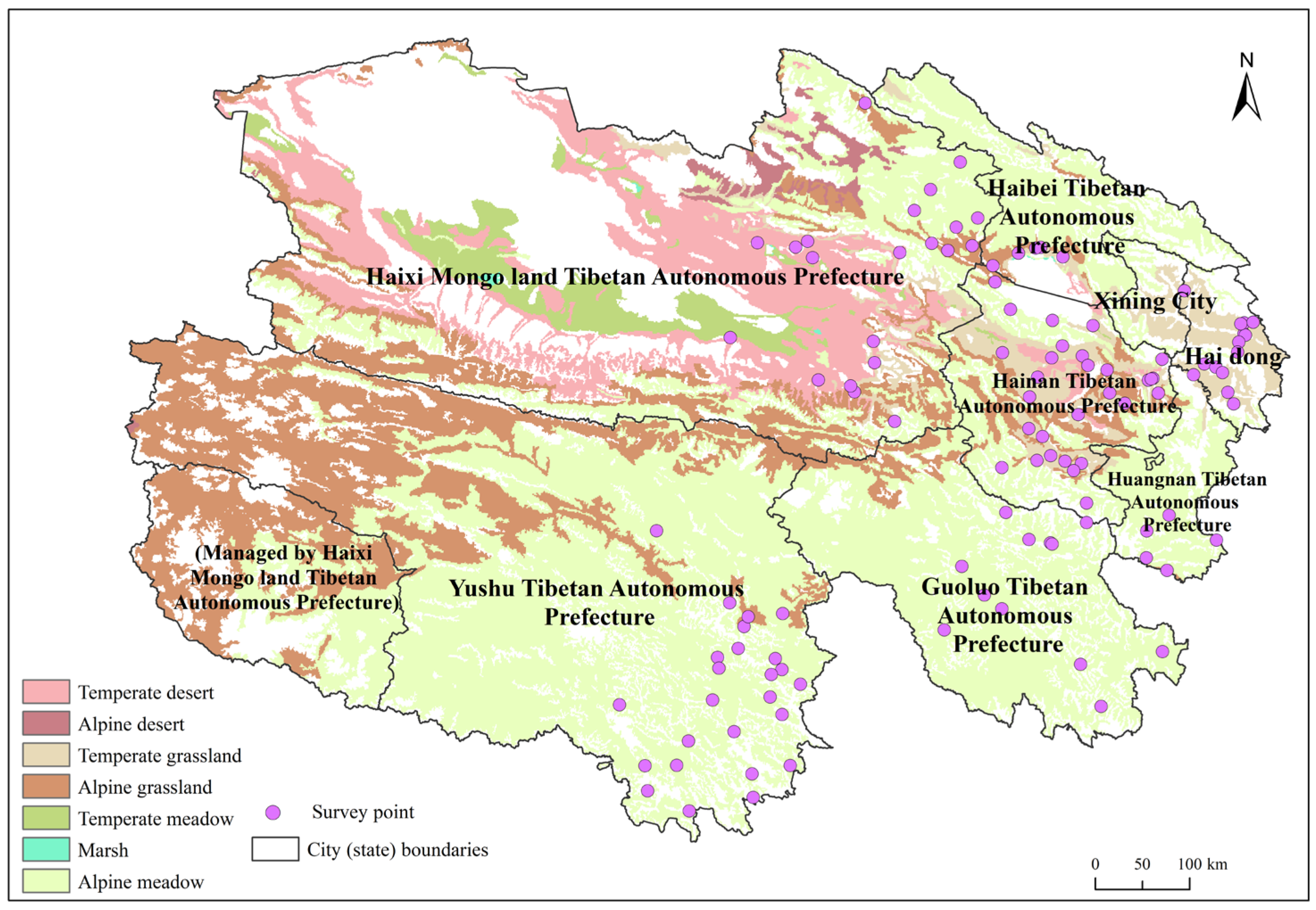
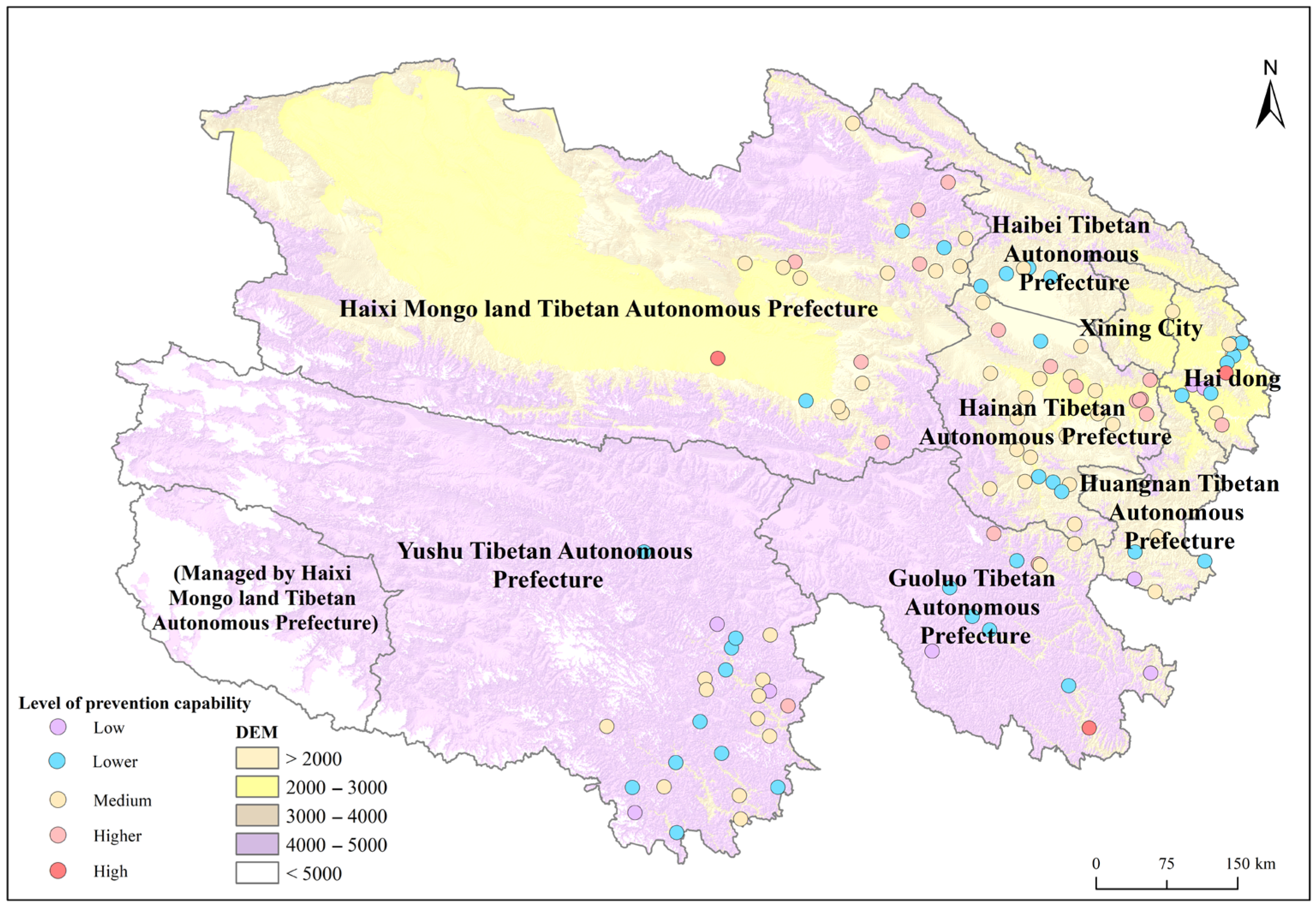
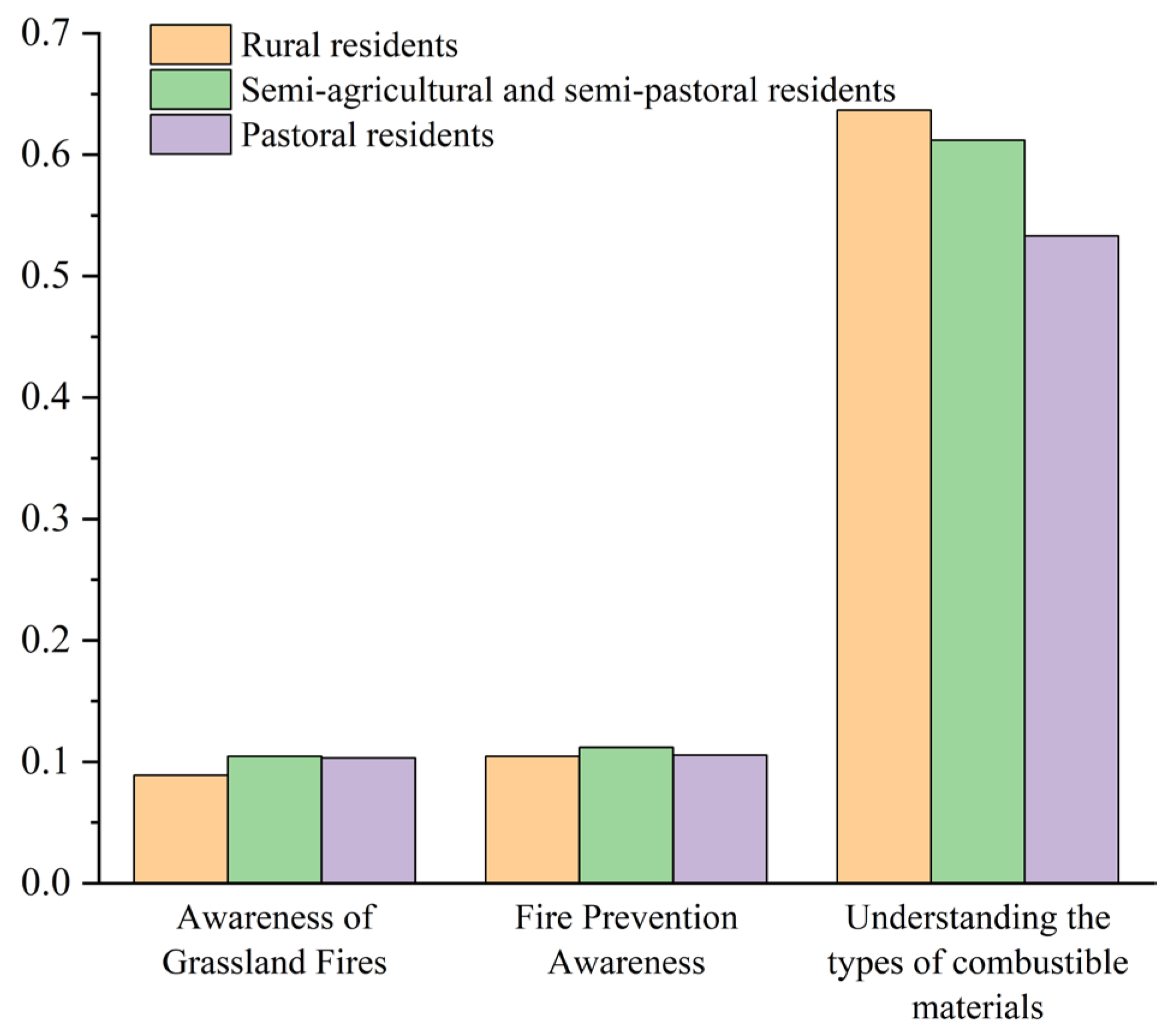
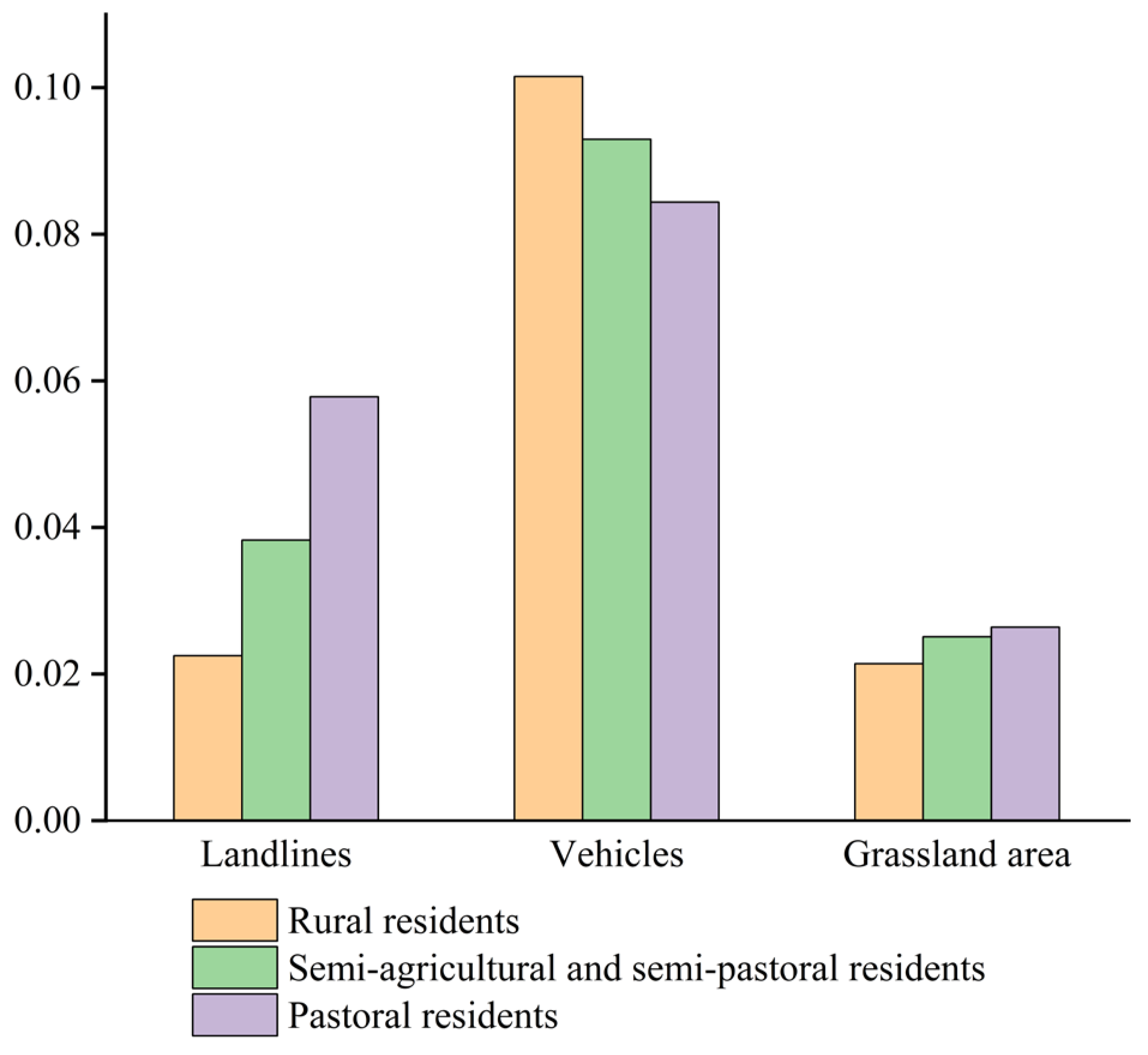
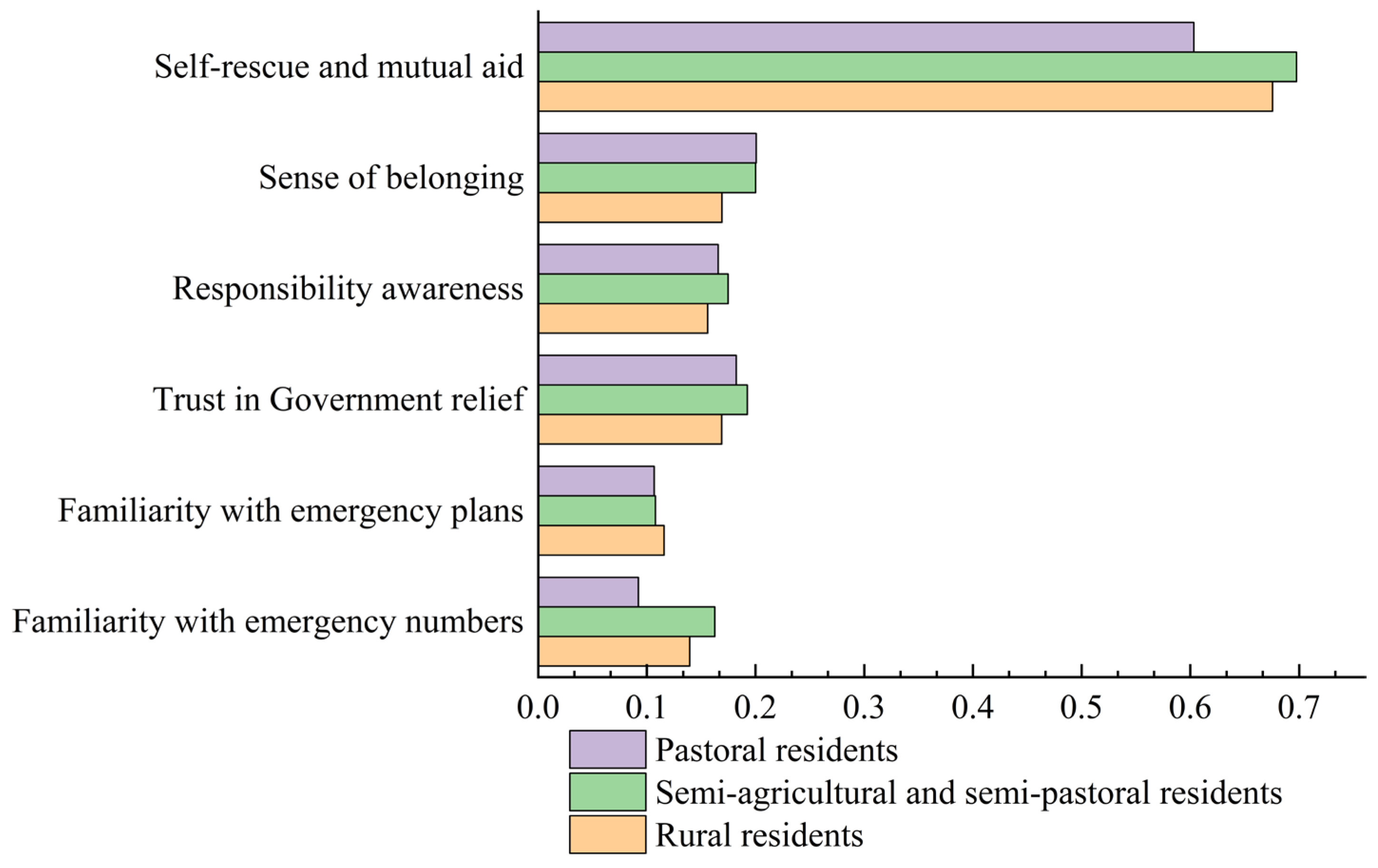
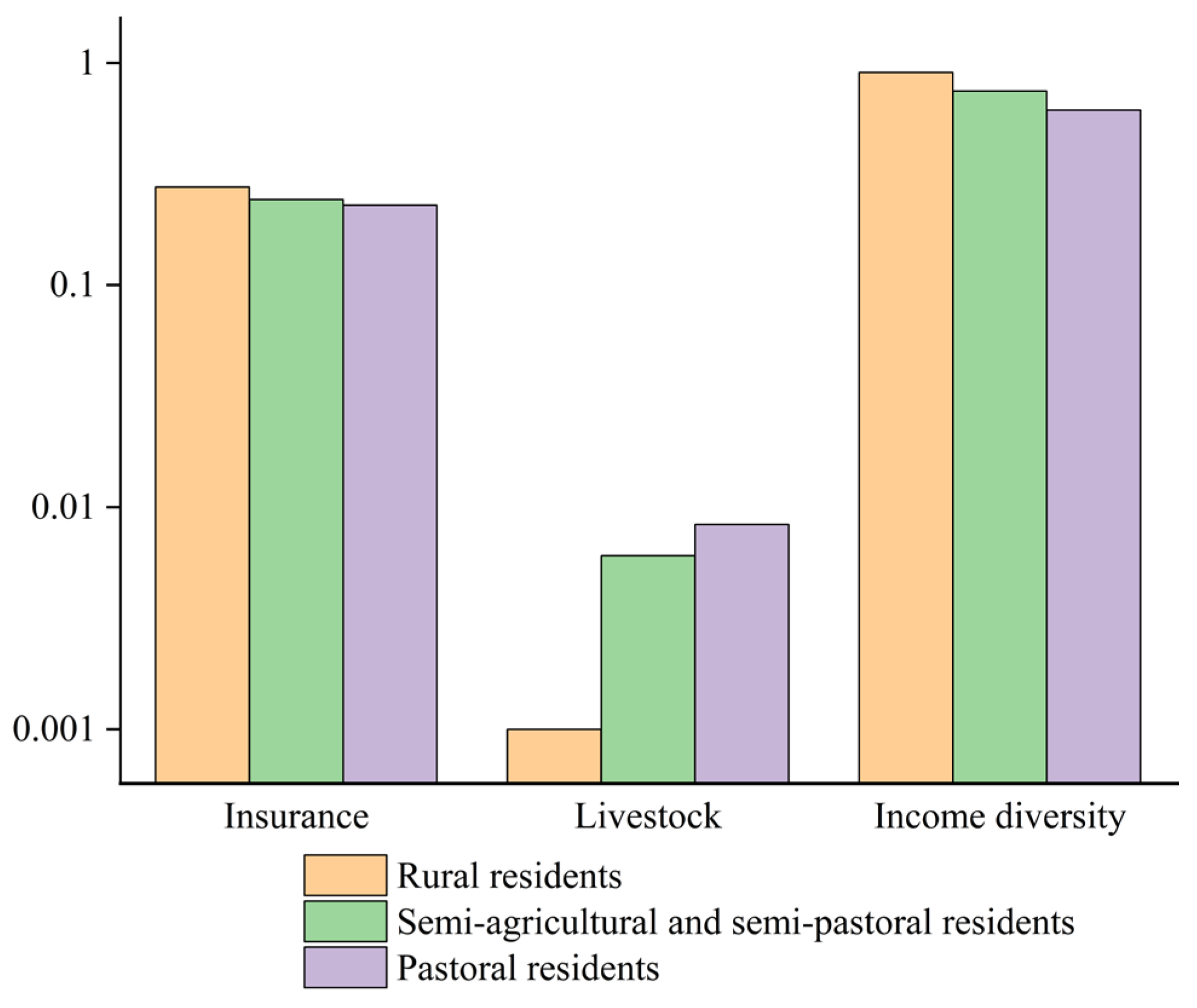
| Capability Dimension | Weighting | Primary Indicator | Weighting | Secondary Indicator | Indicator Description | Weighting |
|---|---|---|---|---|---|---|
| Disaster prevention capacity | 0.15 | Residents’ fire safety awareness level | 0.63 | Awareness of Grassland Fires | Overall understanding of grassland fire knowledge | 0.37 |
| Fire source recognition | Understanding of the types of sources of grassland fires | 0.22 | ||||
| Hazard recognition | Understanding the harmful effects of grassland fires | 0.07 | ||||
| Fire prevention intentions | Willingness to voluntarily learn grassland fire prevention methods | 0.07 | ||||
| Fire Prevention Awareness | Familiarity with the grassland fire prevention period | 0.27 | ||||
| Grassland Fire Prevention Campaign | 0.21 | Frequency of information reception | Frequency of receiving information on grassland fire changes and safety measures | 0.45 | ||
| Proactivity | Proactive search and monitoring of fire-related information | 0.55 | ||||
| Environmental risk awareness | 0.03 | Understanding the types of combustible materials | What are the combustible materials that contribute to grassland fires? | 1.00 | ||
| Fire protection infrastructure completeness | 0.13 | Physical facility perception | Awareness of measures such as fire source isolation and patrol inspections | 1.00 | ||
| Disaster resistance | 0.49 | Family quality endowment | 0.09 | Dependency ratio | The proportion of the total household population aged under 14 and over 64 reflects the vulnerability of the household population. | 0.69 |
| Proportion of women | The proportion of women in the total population of households, and the physiological vulnerability of women compared to men. | 0.11 | ||||
| Level of education | Indicates the level of disaster information reception and judgment capabilities. | 0.20 | ||||
| Family human capital | 0.25 | Proportion of labor force in the household | The proportion of the working-age population in the total household population | 0.04 | ||
| Proportion of village cadres in the village | The proportion of household members who work as village officials compared to the total household population, and the fact that village officials are more familiar with the village’s disaster prevention and relief facilities than ordinary villagers. | 0.96 | ||||
| Family material endowment | 0.66 | Number of landlines | The number of telephones owned by households as a percentage of the total household population | 0.04 | ||
| Number of vehicles | The proportion of private cars owned relative to the total number of people in a household | 0.37 | ||||
| Grassland area | The proportion of grassland area owned by households relative to the total population of households | 0.59 | ||||
| Disaster relief capacity | 0.21 | Individual disaster relief capacity | 0.72 | Familiarity with grassland fire emergency telephone numbers | Familiarity with grassland fire emergency telephone numbers | 0.45 |
| Alarm reporting capability | Familiarity with grassland fire alarm procedures | 0.05 | ||||
| Correct self-rescue judgment | Familiarity with correct self-rescue behaviors | 0.05 | ||||
| Familiarity with emergency plans | Familiarity with emergency plans for the local area | 0.24 | ||||
| The necessity of preparing emergency supplies | The necessity of self-funded emergency supplies | 0.13 | ||||
| Grassland fire emergency response speed | When faced with a fire, the speed and proactiveness of your response actions are crucial. | 0.08 | ||||
| Individual-government cohesion | 0.22 | Government relief to trust | Individuals’ approval of the government’s relief to grassland fires | 0.33 | ||
| Level of understanding of responsibility | Understanding of the government’s responsibility for fire safety management | 0.29 | ||||
| Sense of belonging | Individual responsibility for fire prevention | 0.38 | ||||
| Cohesion between individuals | 0.06 | Neighborhood self-rescue and mutual aid | Neighborhood cooperation in responding to fires and mutual rescue tendencies | 1.00 | ||
| restorative ability | 0.15 | Post-disaster compensation security level | 0.24 | Insurance quantity | Number of individuals purchasing insurance | 1.00 |
| Economic recovery | 0.76 | Livestock numbers | One source of household income | 0.94 | ||
| Diversification of income | The smaller the proportion of livestock income in total income, the greater the diversity of income. | 0.06 |
| Dimension | Independent Variable | Variable Interpretation and Assignment | Mean | Standard Deviation |
|---|---|---|---|---|
| Natural environment | annual average temperature (X1) | Average annual local temperature (°C) | −0.651 | 4.141 |
| annual precipitation (X2) | Mean annual precipitation in the study area (mm) | 421.421 | 103.745 | |
| Dryness (X3) | ArcGIS extraction of dryness of survey points | 2.314 | 1.094 | |
| Risk perception | Possibility of grassland fires (X4) | 1 = Strongly disagree; 5 = Strongly agree | 2.117 | 1.219 |
| Impact on production and daily life (X5) | 1 = Strongly disagree; 5 = Strongly agree | 2.887 | 1.411 | |
| Level of panic (X6) | 1 = Strongly disagree; 5 = Strongly agree | 3.396 | 1.386 | |
| Number of grassland fires experienced (X7) | The variable was coded on a 5-point ordinal scale: 1 = No experience; 2 = 1–2 times; 3 = 3–4 times; 4 = 5–6 times; 5 = 7 times or more | 1.229 | 0.512 | |
| Infrastructure and Services | Road density (X8) | The ratio of domestic highway mileage to the registered population | 7.253 | 5.721 |
| Community committee management capabilities (X9) | Percentage of people receiving social support from neighborhood committees per 10,000 people | 11.452 | 10.339 | |
| Risk communication | Channels for acquiring knowledge (X10) | Number of channels for obtaining fire-related knowledge | 1.653 | 0.814 |
| Public communication on fire safety risks (X11) | Public understanding and awareness of the causes of grassland fires | 2.130 | 1.148 |
| Dimension | Independent Variable | Ordinary Least Squares Method | Quantile Regression | ||
|---|---|---|---|---|---|
| 0.25 | 0.50 | 0.75 | |||
| Natural environment | annual average temperature (X1) | −0.016 (−0.525) | −0.001 (−0.082) | 0.000 (−0.172) | −0.001 (−1.303) |
| annual precipitation (X2) | −0.026 (−0.475) | −0.001 * (−1.932) | 0.000 (−0.955) | 0.000 (0.671) | |
| Dryness (X3) | 0.111 ** (2.020) | −0.002 (−0.624) | 0.005 (1.356) | 0.011 ** (2.523) | |
| Risk perception | Possibility of grassland fires (X4) | −0.015 (−0.520) | 0.000 (−0.291) | −0.001 (−0.550) | −0.002 (−0.991) |
| Impact on production and daily life (X5) | −0.025 (−0.856) | −0.001 (−0.858) | −0.002 (−1.582) | −0.001 (−0.342) | |
| Level of panic (X6) | 0.167 *** (5.924) | 0.006 *** (4.253) | 0.007 *** (4.495) | 0.007 *** (4.278) | |
| Number of grassland fires experienced (X7) | 0.031 (1.136) | 0.003 (0.83) | 0.003 (0.745) | 0.002 (0.369) | |
| Infrastructure and Services | Road density (X8) | 0.081 *** (2.799) | 0.000 (1.264) | 0.001 *** (3.991) | 0.001 ** (2.083) |
| Community committee management capabilities (X9) | −0.020 (−0.668) | 0.000 (−0.870) | 0.000 (−0.753) | 0.000 (−0.829) | |
| Risk communication | Channels for acquiring knowledge (X10) | 0.195 *** (6.901) | 0.013 *** (5.472) | 0.013 *** (5.308) | 0.014 *** (4.822) |
| Public communication on fire safety risks (X11) | 0.212 *** (7.501) | 0.008 *** (4.798) | 0.009 *** (5.280) | 0.012 *** (5.864) | |
| Sample size | 1188 | 1188 | 1188 | 1188 | |
Disclaimer/Publisher’s Note: The statements, opinions and data contained in all publications are solely those of the individual author(s) and contributor(s) and not of MDPI and/or the editor(s). MDPI and/or the editor(s) disclaim responsibility for any injury to people or property resulting from any ideas, methods, instructions or products referred to in the content. |
© 2025 by the authors. Licensee MDPI, Basel, Switzerland. This article is an open access article distributed under the terms and conditions of the Creative Commons Attribution (CC BY) license (https://creativecommons.org/licenses/by/4.0/).
Share and Cite
Xu, W.; Zhou, Q.; Ma, W.; Liu, F.; Li, L. Research on Grassland Fire Prevention Capabilities and Influencing Factors in Qinghai Province, China. Earth 2025, 6, 101. https://doi.org/10.3390/earth6030101
Xu W, Zhou Q, Ma W, Liu F, Li L. Research on Grassland Fire Prevention Capabilities and Influencing Factors in Qinghai Province, China. Earth. 2025; 6(3):101. https://doi.org/10.3390/earth6030101
Chicago/Turabian StyleXu, Wenjing, Qiang Zhou, Weidong Ma, Fenggui Liu, and Long Li. 2025. "Research on Grassland Fire Prevention Capabilities and Influencing Factors in Qinghai Province, China" Earth 6, no. 3: 101. https://doi.org/10.3390/earth6030101
APA StyleXu, W., Zhou, Q., Ma, W., Liu, F., & Li, L. (2025). Research on Grassland Fire Prevention Capabilities and Influencing Factors in Qinghai Province, China. Earth, 6(3), 101. https://doi.org/10.3390/earth6030101







